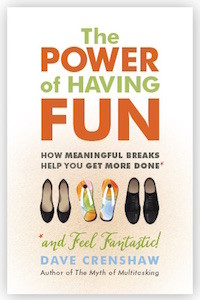
Guest Post by Dave Crenshaw
Do you manage a team of racers galloping at full speed in the chase for success? Well, heed my warning: they may be racing towards complete burnout and a total collapse at the finish line.
It might seem counterintuitive to encourage employee vacations and time off. Often managers view time off as a necessary evil that means work will be delayed, won’t get done at all, or will get passed on to another team member who will be tasked with doing more work, thus limiting their ability to get things done well.
That approach, of course, is looking at short-term problems. In the world of business, it’s best to focus on the long-game. In the long-game, employees taking routine breaks, regular vacation, and using sick time is actually more productive. Here’s why!
For Whom the Bell Rings…
Back when we were kids, we had recess. We counted down the hours, minutes, and seconds until we were free to roam the yard, play tag and make-believe, climb the monkey bars, and attack the jungle gym. We didn’t think about how it impacted our academics, but it did.
A program developed by Texas Christian University titled the Liink Project explored the relationship between childhood play and the connection between performance, focus, and citizenship. To do so, they selected a school and increased their number of recesses each day. The results showed a causal link between “time off” and time well spent in academics. It also saw a reduction in bullying and other behavioral problems.
Such findings have been further validated by The American Academy of Pediatrics, Stanford University, and even the UN.
Wouldn’t it make sense that what works for kids could also work for adults?
The Rhythm Nation
You may be familiar with the concept of your Circadian Rhythm, or “body-clock”. It’s the 24-hour cycle your body goes through each day from the moment you wake up, to the moments you are at peak alertness, and the slow return to slumber mode.
Well, in the study of peak performance, one must also consider our Ultradian Rhythm. Your Ultradian Rhythm governs periods of optimal focus. Typically, you find that a person is about to hit peak productivity for 90-120 minutes before they hit performance decay.
While hard work is radically important for success, so too is taking regular breaks. If the Ultradian Rhythm in an employee’s day can be this powerful, imagine how those same breaks can impact the performance over the course of a year or even over five years. The more time you dedicate to a job, the more vacation and time off you need to recharge your batteries and improve performance.
This of course, assumes the employee will be sticking around for another year. Without encouraging employees to take regular vacations, you actually risk a lot.
Unseen Risks
Employee burnout is a huge problem. One study by the University of Phoenix showed that 59% of the American workforce wishes they had selected different careers. For employees in their 30’s that number jumps up to a whopping 73%. While there are a number of factors that contribute to this, a big one is employee burnout, and, thus, decreased morale and increased turnover.
What do you stand to lose when your best and hardest workers leave your company? The cost of new hires is not insignificant, especially when you add cost of training and limited productivity while getting up to speed. What is the cost of decreased morale? The drop in productivity can be staggering.
Fortunately, encouraging time off actually reverses this trend. One study by the Harvard Business Review and The Energy Project discovered that 81% of employees, when encouraged to take frequent breaks, were more likely stay at their company.
Take Action
If you’re ready to improve your employee performance, take steps to encourage employees to take time-off.
- Lead by Example: Take more breaks, mental health days, and vacations. When the stigma is crushed from the top down, it creates a trend.
- Evangelize: Encourage paid time off in meetings and make it a part of company policy.
- Schedule: Paid time off doesn’t need to be chaotic and random. When employees use a schedule, meetings and events can be moved around and re-prioritized.
Dave Crenshaw is the master of building productive leaders and has transformed hundreds of thousands of business leaders worldwide. He has appeared in TIME magazine, USA Today, Fast Company, and the BBC News. His courses on LinkedIn Learning have received millions of views. He has written four books, including The Myth of Multitasking which was published in six languages and is a time-management bestseller. His newest book, The Power of Having Fun, which this post is based on, was just released this week! Learn more about Dave at DaveCrenshaw.com.














Two things come to mind:
1. I like time off as much as anyone, but I’m not the only one who dreads coming back to a mountain of piled up work. Imbedded in the idea that it is healthy to take time off should be the understanding that it shouldn’t be stressful to return to work.
2. Recess! My son works for a non-profit, Playworks, which contracts with school districts to run recess in elementary schools. They work to provide inclusion and a meaningful break from classes, and schools with Playworks report a 60% reduction in referrals to the principal’s office. Humans large and small need breaks from work!
Hey, Dave, nice name and thanks for the comment!
1) One of the steps I guide readers through in my book is “Protection.” This is because it’s very easy for a variety of obstacles to get in the way of necessary fun. A couple of solutions to the fear of having too much work to do after a break (I call them “Oases” in the book) is to focus on smaller, shorter, more frequent breaks. Another helpful tip is, for a longer Oasis, plan buffer time both before and after. This will allow yourself to leave on a fun trip all caught up, and come back knowing you have enough time to catch up without being rushed.
2) Yes! Part of my goal with “The Power of Having Fun” is to restore recess to the routine of adults, albeit in a more grown-up fashion. Children benefit from free time to play as they see fit, and adults do as well. Many companies are successfully implementing adult recess into their schedule, and it improves productivity and loyalty.
Thank you again for sharing!
Love this. Just bought the book. I am sure I will have fun reading it/ I wrote my first book, Work for a Living & Still Be Free to Live in 1984. No one even thought about overwork. Little did I know I’d be a futurist. This is such a pressing topic. I wonder if we got Congress to play togetnher just for fun, if we’d get better results.
“I wonder if we got Congress to play together just for fun, if we’d get better results.” I love this statement, Eileen!
Thank you so much for buying the book! I’m honored to have a CPAE hall of fame speaker support it.